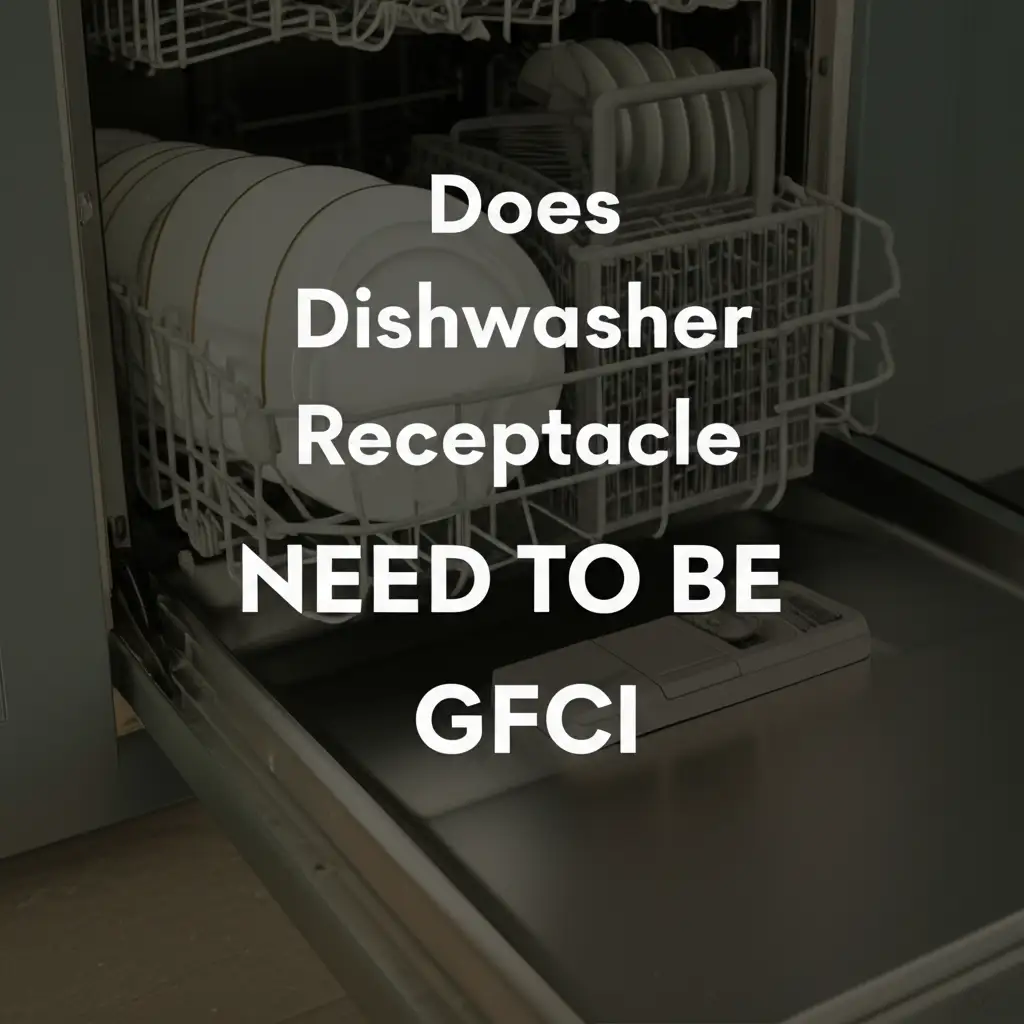· Mason Everett · Appliance Installation · 15 min read
How To Install Electrical Outlet For Dishwasher

Installing a Dishwasher Electrical Outlet: A Complete Guide
A dishwasher brings convenience to your kitchen. To make sure it runs well and safely, you need the right electrical setup. Many dishwashers today use a standard plug, requiring an accessible electrical outlet. Learning how to install an electrical outlet for a dishwasher yourself can save money and give you a sense of accomplishment.
This guide will walk you through the entire process. I will cover everything from understanding electrical codes and gathering tools to the step-by-step wiring process. You will learn about crucial safety measures and how to ensure your new outlet meets all requirements. Let us get your dishwasher ready for action.
Takeaway
- Always prioritize safety by turning off power at the circuit breaker.
- Understand local electrical codes, especially for dedicated circuits and GFCI protection.
- Gather all necessary tools and materials before starting work.
- Follow precise wiring steps for a safe and functional installation.
- Test the new outlet thoroughly before connecting your dishwasher.
Installing an electrical outlet for a dishwasher involves selecting a suitable location, running a dedicated circuit from the main panel, installing an electrical box, and correctly wiring a GFCI-protected outlet. Always turn off power at the breaker before starting and verify with a voltage tester.
Understanding Dishwasher Electrical Requirements and Code
Before you start any electrical work, you must understand the specific power needs of your dishwasher. You also need to know about local electrical codes. Following these rules keeps your home safe and ensures your installation passes inspection. Getting these details right from the start prevents problems later.
Dedicated Circuit for Your Dishwasher
Most modern dishwashers require a dedicated circuit. This means the dishwasher is the only appliance drawing power from that specific circuit breaker in your electrical panel. Typically, a 15-amp or 20-amp circuit is needed. Check your dishwasher’s manual to find its exact power requirements.
A dedicated circuit prevents overloading. Overloading can trip breakers or even cause electrical fires. Running a separate wire from the main panel ensures your dishwasher gets consistent power without affecting other appliances. This is a crucial safety and performance standard. You can learn more about appliance energy use by reading how much electricity dishwasher use.
GFCI Protection is Key
Ground Fault Circuit Interrupter (GFCI) protection is often required for dishwasher outlets. A GFCI outlet quickly detects ground faults and shuts off power. This protects you from electrical shock, especially in areas near water like kitchens. Always check your local codes, but installing a GFCI outlet is a wise safety choice for any kitchen appliance.
You can install a GFCI receptacle or use a GFCI circuit breaker in your main panel. Both methods provide the necessary protection. If you are unsure, consult a qualified electrician. Safety should always be your top concern when dealing with electricity.
Consulting Local Electrical Codes
Electrical codes vary by location. What is acceptable in one city might not be in another. Before beginning your project, contact your local building department. Ask about specific requirements for dishwasher installations, including circuit size, wire gauge, and GFCI rules.
Pulling a permit might be necessary for this type of electrical work. A permit ensures your work gets inspected by a professional. This helps confirm your installation is safe and compliant. Do not skip this step; it protects your home and your family.
Essential Tools and Materials for Dishwasher Outlet Installation
Having the right tools and materials is half the battle when installing an electrical outlet. Being prepared saves time and frustration. It also helps ensure the job is done safely and correctly. Take inventory of what you have and what you need before you begin.
Necessary Electrical Tools
You will need several specific tools for this electrical project. A non-contact voltage tester is crucial for safety. It lets you check if wires are live without touching them. Wire strippers and cutters are essential for preparing electrical wires. A drill will help you create holes for running new wiring.
Other useful tools include a screwdriver set (flathead and Phillips), a level, and a tape measure. You might also need a drywall saw or utility knife for cutting openings for the electrical box. Safety glasses and insulated gloves are also must-have items. Always put safety first when working with electricity.
Wiring and Outlet Components
Selecting the correct wiring and components is vital for a safe and lasting installation. You will need a suitable electrical box for the outlet. This can be a new work or old work box, depending on your wall access. You also need the right gauge electrical wire, usually 12/2 with ground for a 20-amp circuit or 14/2 with ground for a 15-amp circuit. Romex is a common type of non-metallic sheathed cable.
A 15-amp or 20-amp GFCI receptacle is necessary. Ensure it matches your circuit’s amperage. You will also need wire nuts for making secure connections. A new circuit breaker that matches your panel type and the circuit’s amperage will be required at the electrical panel. Gather these items carefully to avoid delays during your project.
Safety Gear and Miscellaneous Items
Beyond electrical tools, personal protective equipment (PPE) is non-negotiable. Always wear safety glasses to protect your eyes from debris. Insulated gloves can add an extra layer of protection, though they are not a substitute for turning off the power. A headlamp can be very useful for working in dimly lit areas like behind cabinets or inside the electrical panel.
You might also need zip ties or cable staples to secure the new wiring once it is run. Electrical tape is useful for marking wires or securing connections temporarily. Keep a fire extinguisher nearby, just in case. Preparedness means safety in electrical work.
Prioritizing Electrical Safety Before You Begin
Electrical work carries inherent risks. Ignoring safety measures can lead to serious injury or worse. Before you even touch a wire, you must take strict precautions. Safety is not just a recommendation; it is a requirement.
Turning Off Power at the Circuit Breaker
This is the most important step. Locate your home’s main electrical panel. Find the circuit breaker that controls the kitchen area or the one you plan to use for the dishwasher. If you are adding a new circuit, you will be working with the main breaker off. Flip the appropriate breaker switch to the “OFF” position.
It is wise to label the breaker that you have turned off. You can use tape or a sticky note. This prevents someone else from accidentally turning it back on while you are working. Do not assume the power is off just because you flipped a switch.
Verifying Power Is Off
Always verify that the power is indeed off before touching any wires. Use your non-contact voltage tester. Touch the tester to the wires you intend to work on. If the tester lights up or beeps, there is still power. Go back to the panel and recheck the breakers. Test multiple outlets or switches on the circuit to be absolutely sure.
Even after confirming no power, treat all wires as if they are live. This mindset helps maintain vigilance. Never work on electrical wiring in the dark or without proper lighting. Good visibility reduces the chance of errors.
Personal Protective Equipment (PPE)
Wearing appropriate personal protective equipment (PPE) is crucial. Safety glasses protect your eyes from dust, debris, or accidental sparks. Insulated gloves can offer a small degree of protection against minor shocks, but they are not a substitute for de-energizing circuits. Wear sturdy, non-conductive shoes.
Keep your work area clean and dry. Avoid working in wet conditions. Remove any metal jewelry that could conduct electricity. If you feel uncomfortable at any point, stop. It is always better to call a licensed electrician than to risk your safety.
Step-by-Step Guide: Running New Electrical Wiring
Running new electrical wiring can seem daunting, but it is a manageable task with careful planning. This part of the installation creates the path for power from your main electrical panel to your new dishwasher outlet. Take your time and plan your route.
Planning the Wire Run
First, decide on the best path for your new electrical wire. It needs to go from your main electrical panel to the desired location of the dishwasher outlet. Consider the shortest, most direct route possible. Avoid running wires where they might be easily damaged or exposed. This usually means running them through wall studs, floor joists, or ceiling joists.
Think about how you will access these areas. Will you need to cut into drywall? Will you be working in a basement or crawl space? Plan your cuts carefully to minimize damage and make repairs easier. Mark the locations for your outlet box and any holes you need to drill for the cable.
Cutting and Routing the Cable
Once you have a plan, start creating the pathway. If you are drilling through studs or joists, use a drill with a long bit. Make sure the holes are large enough for the cable to pass through easily without damage. Always drill in the center of the stud or joist to avoid weakening the structure.
Feed the electrical cable through the prepared holes. Start from one end and push or pull it through to the other. Be careful not to twist or kink the cable. Secure the cable with cable staples or clamps within 12 inches of the electrical box and every 4.5 feet along its run. This prevents the cable from moving or being damaged.
Installing the Electrical Box
Now it is time to install the electrical box where your dishwasher outlet will be. If you are installing in a new wall, use a “new work” box that attaches directly to a stud. If you are adding to an existing wall, use an “old work” box. This box has clamps that secure it to the drywall.
Cut a hole in the drywall precisely to the size of the electrical box. Feed the end of your electrical cable into the knockout opening on the back or side of the box. Secure the box firmly in place. Ensure it is flush with the wall surface and level. Leave enough cable (about 6-8 inches) extending from the box for making connections.
Wiring the GFCI Outlet and Connecting to Power
This is the most crucial part of the installation. Wiring correctly ensures your dishwasher gets power safely and efficiently. Paying close attention to wire colors and connections is vital. Incorrect wiring can be dangerous.
Preparing the Wires
Before making any connections, prepare the ends of your electrical cable. Use wire strippers to remove about 3/4 inch of insulation from the black (hot), white (neutral), and bare copper (ground) wires. Be careful not to nick the copper strands. The goal is to expose enough bare wire for a secure connection to the outlet terminals.
Ensure the ends are clean and straight. If any wire strands are frayed, trim them neatly. This preparation step makes it easier to achieve good electrical contact. A good connection prevents overheating and ensures proper current flow.
Connecting Wires to the GFCI Outlet
Now, connect the prepared wires to the GFCI outlet. GFCI outlets have “LINE” terminals and “LOAD” terminals. The incoming power from the circuit breaker connects to the “LINE” terminals. The “LOAD” terminals are for protecting downstream outlets, which you likely will not use for a dedicated dishwasher outlet.
- Ground Wire: Connect the bare copper ground wire to the green grounding screw on the outlet. This screw is usually at the bottom of the outlet.
- Hot Wire (Black): Connect the black (hot) wire to the brass-colored screw on the “LINE” side of the outlet.
- Neutral Wire (White): Connect the white (neutral) wire to the silver-colored screw on the “LINE” side of the outlet.
Make sure all connections are tight. Gently tug on each wire to confirm it is secure. Once connected, carefully fold the wires into the electrical box, pushing the outlet into place. Screw the outlet firmly to the electrical box. Attach the cover plate.
Connecting to the Circuit Breaker Panel
The final wiring step involves connecting the new circuit to your main electrical panel. Ensure the main breaker is OFF before opening the panel cover. Carefully remove the panel cover. Find an empty slot for your new circuit breaker.
- Ground Wire: Connect the bare copper ground wire to the ground bar inside the panel. This is usually a metal bar with many screws.
- Neutral Wire: Connect the white neutral wire to the neutral bar, which is often next to the ground bar.
- Hot Wire: Connect the black hot wire to the terminal screw on your new circuit breaker.
- Install Breaker: Snap the new circuit breaker into the empty slot in the panel.
Double-check all connections inside the panel. Replace the panel cover securely. If you are unsure about any part of this step, consult a licensed electrician. Working inside the main panel is high-risk.
Testing Your New Dishwasher Outlet
After all the wiring is complete, it is time to test your new electrical outlet. This final step ensures everything works correctly and safely before you plug in your dishwasher. Do not skip testing.
Initial Power Test
Go back to your main electrical panel. Flip the new circuit breaker you installed to the “ON” position. Listen for any unusual sounds or smells from the electrical panel or the new outlet location. There should be none.
If you hear buzzing, sizzling, or smell burning, immediately turn the breaker off. Do not proceed until you have identified and fixed the issue. These are signs of a serious electrical problem. Call an electrician if you cannot find the source of the issue.
Testing with a Voltage Tester
With the breaker on, return to the new dishwasher outlet. Use your non-contact voltage tester again. Hold it near the outlet slots. The tester should light up or beep, indicating that power is present. Next, use a standard outlet tester (a small plug-in device with indicator lights). Plug it into the new GFCI outlet. The lights on the tester will tell you if the outlet is wired correctly.
Most outlet testers will indicate correct wiring, open ground, open neutral, or reversed polarity. If the tester shows any error, immediately turn off the breaker and recheck your wiring connections. Ensure the “LINE” and “LOAD” terminals are correctly used on the GFCI outlet if applicable.
Final Check with Dishwasher
Once your outlet tester confirms correct wiring, push the “TEST” button on the GFCI outlet. It should trip, meaning the power to the outlet shuts off. This confirms the GFCI protection is working. Press the “RESET” button to restore power.
Finally, you can plug in your dishwasher. Turn on the dishwasher and run a short cycle or test function. Listen for proper operation and observe if it receives power without any issues. If everything works as expected, congratulations! You have successfully installed an electrical outlet for your dishwasher. For installation alternatives, you might consider services like what does lowes charge to install dishwasher.
Frequently Asked Questions (FAQ)
Do dishwashers need a dedicated circuit?
Yes, most modern dishwashers require a dedicated 15-amp or 20-amp circuit. This means the dishwasher is the only appliance on that specific circuit breaker. A dedicated circuit prevents overloading, which can trip breakers or lead to electrical hazards. Always check your dishwasher’s manual and local electrical codes.
What type of outlet is needed for a dishwasher?
A standard 120-volt, 15-amp or 20-amp grounded receptacle is typically needed. For safety, especially in kitchens, this outlet should also have Ground Fault Circuit Interrupter (GFCI) protection. You can use a GFCI outlet itself or have GFCI protection provided by a GFCI circuit breaker in your electrical panel.
Can I use an extension cord for my dishwasher?
No, you should never use an extension cord for a dishwasher. Dishwashers draw a significant amount of power, and extension cords are not designed for such continuous, heavy loads. Using an extension cord can lead to overheating, electrical fires, or damage to the appliance. Always plug your dishwasher directly into a dedicated, properly installed outlet.
Is GFCI required for a dishwasher?
In most current electrical codes, GFCI protection is required for outlets serving kitchen countertops, which often includes the area where a dishwasher is located. While some older installations might not have it, new installations almost always require it for enhanced safety against electrical shock, especially in wet environments.
How long does it take to install a dishwasher outlet?
The time it takes to install a dishwasher outlet varies greatly depending on your experience and the complexity of the job. If you are experienced and have easy access to the electrical panel and outlet location, it might take 2-4 hours. For DIYers new to electrical work or needing to run new wiring through walls, it could take 4-8 hours or more.
Do I need a permit to install a dishwasher outlet?
For any electrical work that involves adding a new circuit or modifying existing wiring, most local jurisdictions require a permit. Getting a permit ensures your work is inspected by a qualified professional. This helps ensure your installation is safe, code-compliant, and protects your home’s value. Always check with your local building department.
Conclusion
Installing an electrical outlet for a dishwasher is a significant home improvement project. It requires careful planning, adherence to safety protocols, and precise execution. By following the steps I have outlined, you can confidently set up your dishwasher’s electrical connection. Remember to always prioritize safety by turning off power and verifying with a voltage tester before touching any wires.
Understanding your dishwasher’s power needs, local electrical codes, and the importance of GFCI protection are fundamental. A properly installed dedicated circuit ensures your appliance runs efficiently and safely for years to come. If you ever feel uncertain about any step, especially when working inside the electrical panel, do not hesitate to consult a licensed electrician. Your safety and the safety of your home are paramount. Now, enjoy the convenience of your perfectly powered dishwasher!





